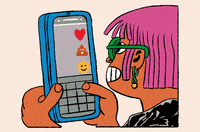“OMG, he slid in her DMs and he was flexing. She totally curved him, it was phat to watch”
“LOFL, he’s such a noob”
“IKR! But she’s also emo, TBH”
“LOL, r u throwing shade at her?”
“She is such a tool, bruh”
“Ait bae, gotta go. Was dope chattin”
“KK”
I may have made that conversation up, but rest assured, this is definitely what a real text conversation looks like between your teen and their friends. Even auto-correct simply gave up trying to decipher this coded millennial vocabulary. But, can you?

Quick facts about teen text-messaging
According to a 2018 Pew Research Study, nearly 95 percent of US teens had access to a cell phone, and nearly 45 percent of them said they were “online constantly”. Likewise, as of 2010, the average teen was sending and receiving around 3,339 text messages per month (when do they even study?). Between slang and short-form language that’s more conducive to quick texts, these messages have morphed into a language only they understand.
The dark side to all this? Teens are growing more and more comfortable with a language that’s relatively unfamiliar to the rest of us, which in turn has significantly impacted their ability to write proper words and speak proper English. What’s more, texting in general may be limiting their social interactions as they’d much rather text than have face-to-face conversations.

A short dictionary for parents
Being radical doesn’t mean you belong to an extreme sect of a political branch; phat doesn’t mean you need to go to Weight Watchers; sick doesn’t mean you require medical attention, and dope has nothing to do with drugs. All these words mean one thing; COOL.
A Bae in teen talk stands for “Before Anyone Else.” It’s used to describe a boyfriend, girlfriend, or good friend. Bruh isn’t that undergarment that supports your breasts, it means “Bro or dude” in teen lingo and is used gender neutrally.
To curve is to reject or ghost someone romantically and emo refers to someone who is too emotional or a drama queen.
A newbie or a person who doesn’t know what they are doing is known as a Noob and a Tool is someone who is stupid, obnoxious, rude, and/or embarrasses themselves (I know a few tools!).
The teen-text/talk vocabulary list is endless.

Beware
All this teen talk is largely harmless (except for their school grades). However, there are codes to look out for in such conversations that may be potentially dangerous to them and others.
53X means “sex” and CU46 means “see you for sex.” Molly is not her best friend’s name, it’s a euphemism for the dangerous party drug ecstasy. Smashing means having casual sex and the plug is someone that supplies drugs and/or alcohol that will leave them turnt (high or drunk). “X” doesn’t mark the spot, it too stands for ecstasy. WTTP is “Want to trade photos?” And LMIRL means “Let’s meet in real life.”
Again, the list is non-exhaustive – if for no other reason than it’s constantly evolving and being added to – and parents should watch out for these and many other dangerous conversations, as well as signs of cyber-bullying, which is a growing trend among tech-savvy, texting teens.
Not all bad
For many of us, texting generally lets us say what we want without being interrupted. I have found emotional relief and I have strengthened friendships through texting. So, it’s not all bad.
For teens, texting reportedly has a positive impact too (bad grammar notwithstanding). Introverted youth may see this as an alternate way of communication. Texting may help them relay what they otherwise wouldn’t during a face-to-face interaction.
Our “tween” daughter is soon getting her own mobile phone. Phat, right? IMO, I will not be a noob in deciphering her texts. OMG!
KEEP READING When Two (Cultures) Become One: Differences In Cross-Cultural Marriages
Images: Giphy, Pexels




